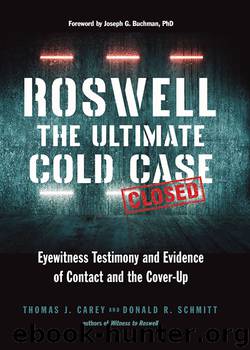Roswell by Thomas J. Carey

Author:Thomas J. Carey
Language: eng
Format: epub
ISBN: 9781632657640
Publisher: Red Wheel Weiser
CHAPTER 9
Searching for the On Button
It was a spaceship. After all these years, I still don't know how that thing flew. There were no moving parts. There was no engine! Before I go, I want you fellas to promise me that you will find out. I'd like to know.
—SERGEANT WILLIAM C. “BILL” ENNIS, 393rd
Bomb Squadron, RAAF, Roswell, NM, 1947
In July 2008, while we were in Roswell for the yearly UFO festival, we introduced Earl Fulford to Bill Ennis. In 1947, Sergeant William C. Ennis was a flight engineer with the 393rd Bomb Squadron at the RAAF. Hangar P-3 was the primary facility of the 393rd at the time of the incident, as well as the primary receiving facility for the wreckage and bodies recovered from the UFO crash. It stood to reason that anyone who worked in that hangar might know something. We had interviewed Ennis in person years before, in 1992, but all he would offer us was to laugh everything off as just a “weather balloon.” After years of denial, and after meeting Earl Fulford, Ennis allowed, “Whatever Earl told you [see Chapter 6] is all true.” It would take an additional meeting later in 2008 to obtain Ennis's final confession, which is cited in the opening quote above. Unfortunately, Ennis passed away before we could give him the answer to his question.
When Corona sheep rancher Mack Brazel heard a strange, muffled explosion among the thunderclaps during a severe lightning storm late on the evening of July 2, 1947, he had no idea what it could be.1 “The lightning seemed to be attracted to a single location on the ranch,” he would later tell his son Bill. Some of Brazel's neighbors also told of hearing the explosion.2 The following day, as he gazed upon one of his pastures now covered by pieces of silvery wreckage, he still had no idea what it was. Without electricity or a radio and with only weekly or monthly newspapers, he had not heard about the “flying saucers” that had made their historical appearance only two weeks previously. It wasn't until Brazel had paid a visit to his close neighbors the following day, and to a Corona bar on July 5, that he heard about them—as well as a possible reward for finding one. Early the following morning, July 6, he would find something else on his ranch, something that convinced him to make the dusty drive to Roswell to report his finds, thus securing his place in history and initiating one of the greatest mysteries of the twentieth century.
Leaving the something else for another chapter, what was it exactly that was deposited in small pieces in Brazel's sheep pasture, concentrated so densely in a fan-shaped pattern up to 1.5 million square feet that summer of 1947? From various sources both military and civilian who saw and/or handled pieces of the wreckage, it consisted mostly of two major types of wreckage:
A large quantity of small, palm-sized pieces of smooth, very thin, very light
Download
This site does not store any files on its server. We only index and link to content provided by other sites. Please contact the content providers to delete copyright contents if any and email us, we'll remove relevant links or contents immediately.
The Secret History by Donna Tartt(16656)
The Social Justice Warrior Handbook by Lisa De Pasquale(11492)
Thirteen Reasons Why by Jay Asher(7801)
This Is How You Lose Her by Junot Diaz(5797)
Weapons of Math Destruction by Cathy O'Neil(5046)
Zero to One by Peter Thiel(4834)
The Myth of the Strong Leader by Archie Brown(4795)
Promise Me, Dad by Joe Biden(4455)
Beartown by Fredrik Backman(4433)
Stone's Rules by Roger Stone(4422)
How Democracies Die by Steven Levitsky & Daniel Ziblatt(4412)
The Fire Next Time by James Baldwin(4350)
100 Deadly Skills by Clint Emerson(4085)
A Higher Loyalty: Truth, Lies, and Leadership by James Comey(4038)
Rise and Kill First by Ronen Bergman(4019)
The David Icke Guide to the Global Conspiracy (and how to end it) by David Icke(3891)
The Farm by Tom Rob Smith(3878)
Secrecy World by Jake Bernstein(3788)
The Doomsday Machine by Daniel Ellsberg(3736)
